 |
| Kanbara Kannon-do Hall courtesy of トカ太(Tokata) |
 |
| Kanbara Kannon-do Hall courtesy of トカ太(Tokata) |
 |
| Kanbara Kannon-do Hall courtesy of トカ太(Tokata) |
The hall has 15 stone steps now. Legend has it that Kannon-do had 150 stone steps. In 1979 the grounds of the hall was examined. The hall had once had 50 stone steps. Debris buried its 35 steps(6.5 meters in height .)
And two female skeletal remains(partially mummified) were found.
 |
| Kanbara Kannon-do Hall courtesy of トカ太(Tokata) |
Mount Asama straddling the border between Gunma and Nagano Prefectures has often erupted. In 1783 the eruption reached its peak about 10:30 a.m. on August 5(the 8th day of the 7th month in the lunar calendar) after the volcano had repeated small eruptions. The eruption issued a large amount of pyroclastic fall, lava flow, pyroclastic flow, debris avalanche and lahar. (mudflow). Experts infer that debris avalanche battered Kanbara village. It crushed 957 homes and left 1,443 people dead in an area surrounding the mount.
The two remains were found at foot of the hall's steps. They are considered as parent and child or younger and much older siblings because two restored faces are quite similar. Younger woman was about to give older one a piggyback ride up the steps. They were so close to survival, but just couldn't survive the debris avalanche.
There are also other opinions. Some people say that there was no time to evacuate and that people happened to be at the hall to pray for the end of volcanic eruption. Another says that there was 10 minutes to evacuate because the speed of debris avalanche was estimated to be about 30 or 40 kirometers per hour.
The survivors were 80 villagers who stayed outside the village and 51 who were able to reach the hall, a neighboring village and a nearby mountain, happened to survive in a hut, a field, a survivor's house. After the disaster 93 Kanbara's survivors remained in the village. Five neighboring village headmen rode to rescue of 93 survivors. In the end 55 survivors have remained in Kanbara ever since. Most survivors in other devastated areas abandoned their villages.
The Kanbara's survivors re-established their village in the same place. Widowers got married widows. Parents of deceased children adopted orphans.
I have heard a man talking on a TV program before. As I got a strong impression from his talk, it is remembered to this day.
A presumed descendant of the survivors said, "A man asked the survivors, 'Why didn't you abandon your village?' They answered, 'Because we couldn't bear to leave our family members behind. They are buried under here.'"
Though it's uncertain as to whether or not he talked about the 1783 Asama Eruption, there is no other instance like the reconstruction of Kanbara village.
Kanbara was a pastoral village and yet a strategic spot on the road. Inns, wholesale stores, tea shops lined both sides of the street. The Edo Shogunate disbursed 1,050 ryo(approx. 136 million yen at present value) to Kanbara village and 4,766 ryo(approx. 620 million yen at present value) to 19 seriously damaged villages for post-eruption recovery. Actually, the Shogunate ordered Kumamoto Domain to pay 100,000 Ryo as reconstruction aid. The domain could not afford to pay the huge sums of money, so the domain's residents paid a lot of money. After the Kumamoto earthquakes occurred in 2016, Kanbara residents raised money for victims of the quakes. They thank Kumamoto citizens to this day.
 |
| Stone monument to commemorate the 32nd death anniversary of the victims (33回忌供養碑) courtesy of トカ太(Tokata) |
The surviviors held a Buddhist memorial service on the 32nd death anniversary of the victims in 1815. At the same time they built a monument with carved names of the victims by receiving a helping hand from neighboring villages.
 |
| Stone block bearing the name of Enmei-ji Temple courtesy of トカ太(Tokata) |
Enmei-ji Temple(延命寺) was buried by the eruption. The temple's chief priest was engulfed in the eruption on his way to the Mount Asama on that day. He headed for the volcano to pray to end its eruption. The location and existence of the temple was unknown. Ironically, the stone block was found at the riverside of the Agatsuma River due to flooding of the river in 1910.
The remains of its constructions was confirmed buried 6.5 meters under the ground, 200 meters from Kannon-do in 1980. Artifacts including Buddhist ritual objects had been discovered through six examinations since 1985.
The remains of folk houses at Tooka-no-kubo(十日ノ窪) were examined in 1979 and 1980. About 2,000 housewares were found. They included some articles such as a lacquer comb, a tortoise shell hairpin, a mercury mirror, a tea bowl and a kettle for the tea ceremony. Their owners were commoners.
 |
| Monument to the Asama Eruption, gravestones, and Okomori-do courtesy of トカ太(Tokata) |
Okomori-do is a building with hanging towels located behind stonegraves. Kannon-do became known to the whole country after examination in 1979. The hall had an increasing number of tourists. In 1979, 7th and 8th generation descendants of the survivors and their relatives, newcomers after the eruption, launched Kanbara Kannon-do Hoshikai(service club.) They take turns to receive visitors. They offer prayers to the victims, hold memorial service for the victims on August 5 every year.
As of 2001, about 80 percent of Kanbara village residents were the descendants of the survivors. So they had a tremendous amount of respect for Kannon(Goddess of Mercy) enshrined in Kannon-do who saved dozens of survivors. Villagers who helped the excavation works had strong sense of prayer. They saw the lifestyles of their ancestors and felt the pains of the victims. Kannon-do is also a meeting place for residents.
A memorial service called mawari-nenbutsu takes place twice a month. Homes used to take turns providing a venue for it. It is held at a local multipurpose center now. Not all homes participate in it. In the venue, three hanging scrolls with the names of the 477 victims, the Thirteen Buddhas, Kobo-Daishi(Kukai) are displayed. Participants chant some nenbutsu(prayers to Amitabha Buddha) and wasan. Wasan are Buddhist hymns in Japanese. Wasan chanted here were made in the Meiji Period. They represent the tragedy of the 1723 Asama eruption and a prayer to Amitabha Buddha.
Tsumagoi Kyodo Shiryokan(嬬恋郷土資料館, Tsumagoi Folk Museum)
The museum shows artifacts, illustration of damage, an erupting volcano diorama, restored faces of two women who were found at foot of Kannon-do's steps. Visitors can see views of Mount Asama and current Kanbara area in the observation room.
Tsumagoi Kyodo Shiryokan(Japanese version only):
https://www.vill.tsumagoi.gunma.jp/shiryo_kan/index.html
Tsumagoi Village is Japan's top producer of cabbages and is a popular tourist destination.
 |
|
|
 |
| Palcall Tsumagoi Ski Resort in Tsumagoi, Gunma, Japan. From Wikimedia Commons |
The Lava covered about 6.8 square kilometers of the surrounding forest, forming a flow field 800-2,000m wide and extending 5.5 km to the north. The analyses of the welded pyroclastic rocks show that the Oni Oshidashi lava is considered to be clastogenic lava. Pyroclastic material ejected from a volcanic vent piled up around the vent in the shape of a cone with a central crater. A high flux of pyroclast accumulation around the vent led to clastogenic lava flows from the northern lowest rim of the summit crater. "Oni Oshidashi" means "lava that an ogre pushed outward from a volcano."
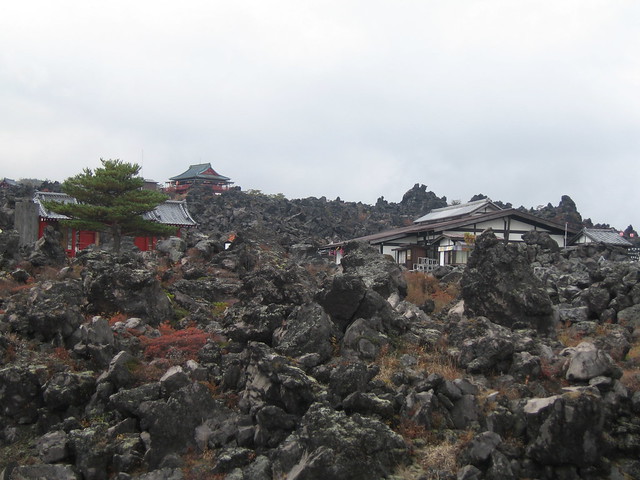 |
| Oni Oshidashi 鬼押出し (credit: duke.yuin/ flickr) |
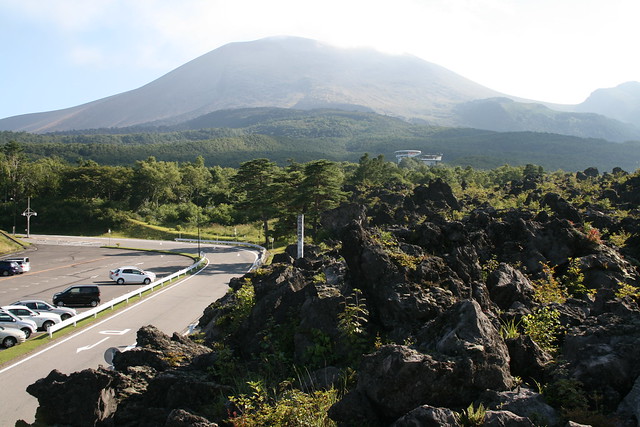 |
| Oni Oshidashi IMG_0715.JPG (credit: bizmac/flickr) |
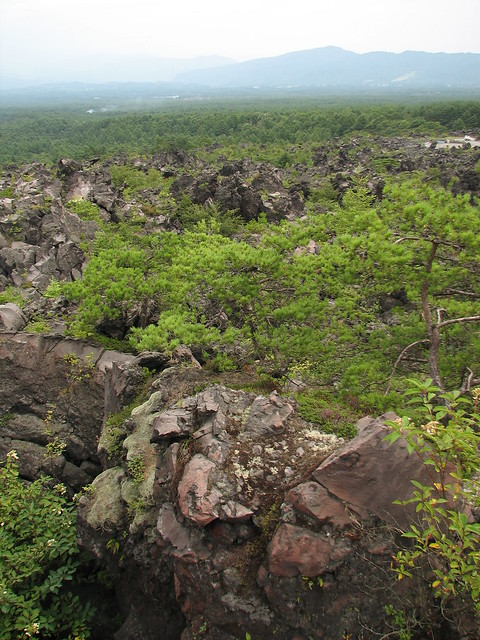 |
| onioshidashi_03 (credit: yamakidoms/flickr) |
 |
| Mt.Asama as seen from Onioshidashi, Tsumagoi Vill., Gunma Pref., Japan credit:Σ64 from Wikimedia Commons |
Visitors can see the Oni Oshidashi lava at the Onioshidashi-en(鬼押出し園, Onioshidashi Park) or the Naganohara town municipal Asama-en(浅間園, Asama Park).
The Onioshidashi Park is located near Karuizawa. The Kokudo Corporation developed Onioshidashi as a tourist site. Now Prince Hotels manages the park.
In the park Kannon-do(a branch temple of Kan'ei-ji Temple in Ueno, Tokyo) was built to mourn for the victims in 1958. The survivors of the volcanic eruption sought rescue from the Kan'ei-ji Temple. The chief priest of the Zenko-ji Temple in Nagano Prefecture(the former chief priest of the Kan'ei-ji) came to the disaster area, provided meals to the survivors, and chanted a prayer for the victims for 30 days. In the following year, 1784, the priest held a memorial service for the victims at the Zenko-ji Temple.
 |
| Asamayama Kannon-do 浅間山観音堂 (credit:duke.yuin/ flickr) |
 |
| Asamayama Kannon-do
from Wikimedia Commons
|
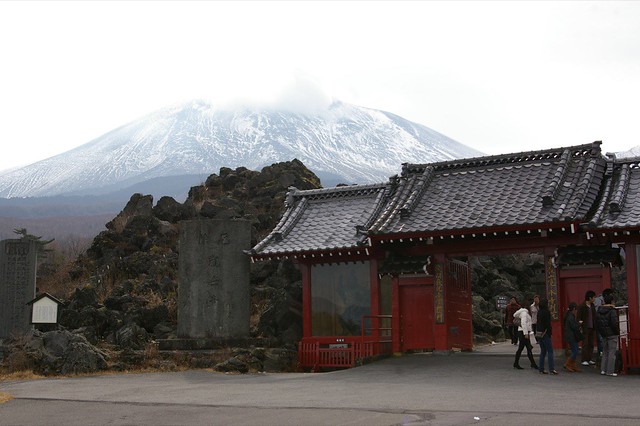 |
| Asamayama Kannon-do 鬼押し出し (credit: Nao Iizuka/ flickr) |
The Naganohara town municipal Asama-en has the Asama Volcano Museum, a volcano walk, a trekking course(need for guide, since Mt. Asama is a volcano. Small eruptions sometimes occur at Mt. Asama. Advance reservations are required), a trailer site, a cycleway in the forest, and a motorcycle museum(almost Japanese classic bikes.)
 |
| Asama Volcano Museum credit:京葉快速26 from Wikimedia Commons |
the Onioshidashi-en (Japanese version only):
Naganohara town municipal Asama-en(Japanese version only):
The Great Tenmei famine is considered to have set in 1782, and lasted until 1788. The 1723 Asama eruption contributed to the famine. Volcanic ash was sent down around Japan, resulting in cold weather that led to catastrophic crop failure. Mount Iwaki in Aomori Prefecture also erupted in 1783.
In Iceland, the Laki volcanic fissure erupted over an eight-month period between June 1783 and February 1784. The Laki eruption and its aftermath affected the whole of the northern hemisphere.
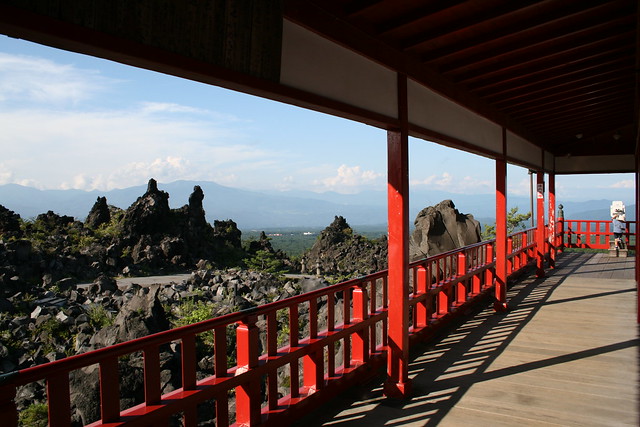

No comments:
Post a Comment